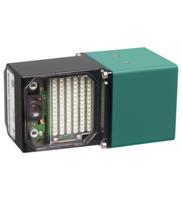Vision Sensors Detect Incorrect Sheets in Print Finishing
Task
High-speed printing and binding applications often require sheet identification, to ensure that the correct printed materials are attached to a product or package. An example of a critical need for correct sheet identification is packaging inserts for pharmaceuticals. A mix-up here could be disastrous!
A sheet verification method used on printing and finishing applications actually labels the individual sheets with a barcode or Data Matrix code. This solution is not optimal due to:
- Added cost of applying barcodes or Data Matrix codes
- Barcodes may be removed or truncated early in the printing process
- Unreadable or unavailable barcodes do not support product inspection requirements
- Barcode readers with common line scan design can only detect codes in lateral orientation to sheet movement
As an alternative to barcode readers, there are image comparison solutions. However, these can be expensive and difficult to install.
Implementation

The sheet identification sensor VOS410-BIS compares both print images and Data Matrix codes
Pepperl+Fuchs’ solution uses vision sensors to detect incorrect sheets based on the actual printed image on the sheet. The different image types (text, photographs and graphics) must be detected at the high speeds produced by printing/ finishing machinery.
Pepperl+Fuchs developed the sheet identification sensor VOS410-BIS to meet these production and inspection requirements. The vision sensor monitors the correct sheet fold in collating and folding machines, and proofs the conformity of the actual camera image with a previously taught-in reference image or reference code. The VOS410-BIS vision sensor has been developed specifically for the graphics industry.
Put into practice
The German company Wohlenberg Buchbindesysteme (Wohlenberg Bookbinding Systems) is using Pepperl+Fuchs’ vision sensors in collating machines and adhesive binders to detect incorrect sheets.
The sensor’s camera, lighting and processing unit is integrated into a complete compact system, which does not need any external processing unit. Barcode and image comparison evaluation methods are contained in one device, significantly reducing integration time and costs.
With a maximum sheet speed of 6 m/s and a cycle time below 80 ms, the vision sensor is ideal for high processing speeds, and still has free resources for faster processes in the future! Functionality is further enhanced with the integrated rotary encoder interface for simultaneous offset of the trigger point. An error image memory stores image results and allows the simulation of false detections. This memory supports the customer during setup and when analyzing problems. In normal operation mode, the fast image transfer enables a visual check and image verification.
Pepperl+Fuchs provided a very viable solution for Wohlenberg Bookbinding Systems. Wohlenberg noted a primary reason for selecting the vision sensor was its long-term availability, since the sensor is produced entirely by Pepperl+Fuchs.

VOS410-BIS-60-WH vison sensor






 +420 225 989 180
+420 225 989 180